
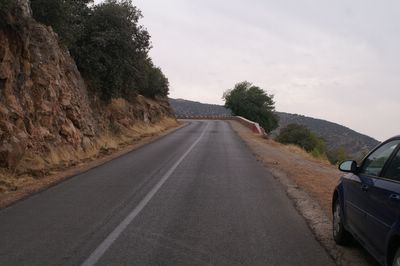
What used to be a blog about experiencing the places and cultures of the world has morphed into one of living in my adopted home of Wyoming.

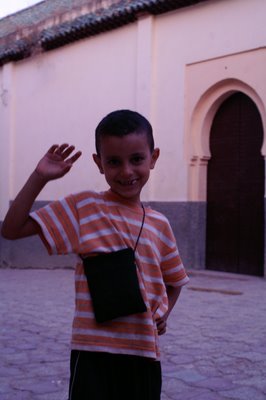
 The ruins at Volubilis.
The ruins at Volubilis.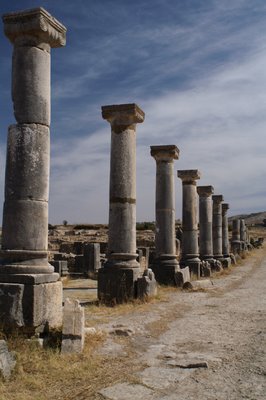 Remains of an old olive press.
Remains of an old olive press. 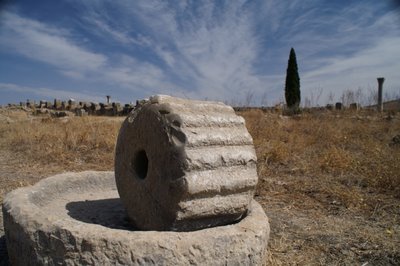 View of either the capital, the bascilica, or the forum. Each is reputed to have been built on the high point, where this set of ruins were, but aside from maybe four small brief signs posted in the area, there was no other information. Shame on Unesco....
View of either the capital, the bascilica, or the forum. Each is reputed to have been built on the high point, where this set of ruins were, but aside from maybe four small brief signs posted in the area, there was no other information. Shame on Unesco....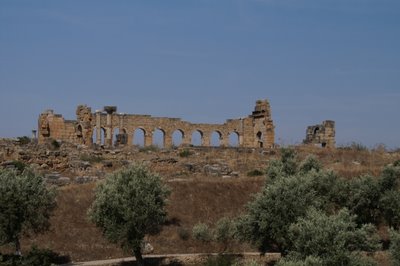
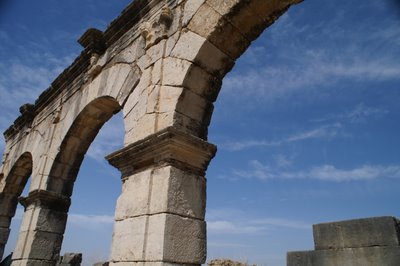 Inscription over the Triumphal Arch.
Inscription over the Triumphal Arch. For more of these, click here.
For more of these, click here.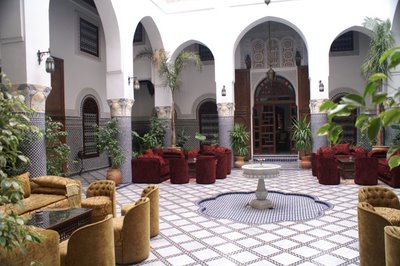 Activity within a Carpet Shop. Which just happened to also be in an old Riad.
Activity within a Carpet Shop. Which just happened to also be in an old Riad.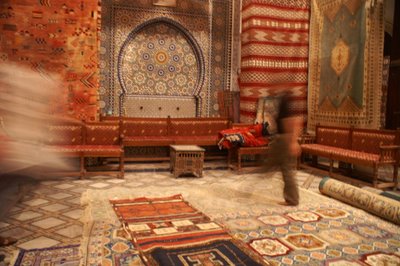 Rooftop view of Fes. I looked back through several hardcopy photos from previous visits, and find it interesting that the plethora of antenna eyesore material has been largely replaced by the somehow less bothersome appearance of satellite dishes. Note the carpets airing on the nearby rooftop ledges.
Rooftop view of Fes. I looked back through several hardcopy photos from previous visits, and find it interesting that the plethora of antenna eyesore material has been largely replaced by the somehow less bothersome appearance of satellite dishes. Note the carpets airing on the nearby rooftop ledges.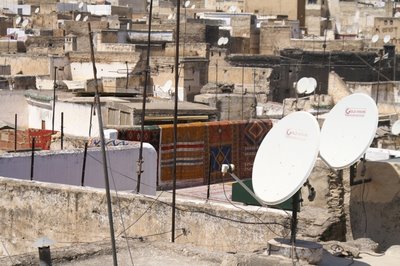 Inner courtyard tranquility.
Inner courtyard tranquility.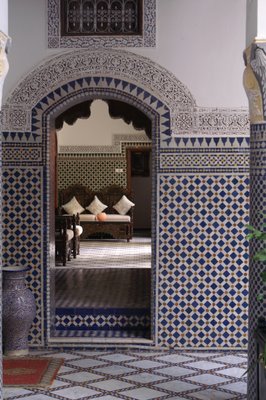
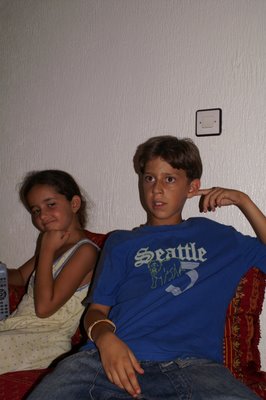
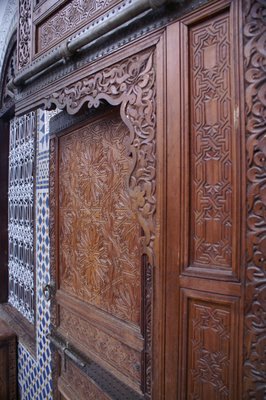 The above is the door to my guest room at the riad. It was really a door within a door, and these doors opened to a beautiful set of stained glass doors as well (below). Those above are of cedar and smell wonderful.
The above is the door to my guest room at the riad. It was really a door within a door, and these doors opened to a beautiful set of stained glass doors as well (below). Those above are of cedar and smell wonderful. 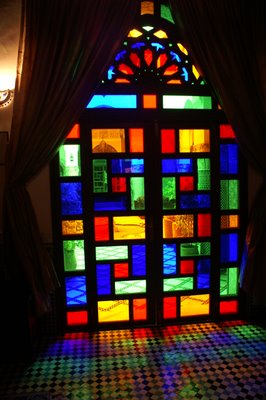
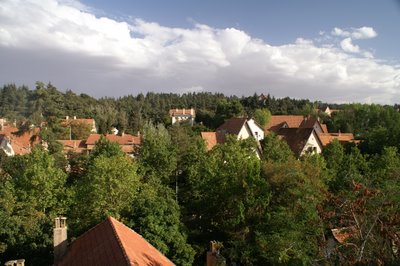 Since I had a little time (about 2 days) before heading to Marrakech to meet Alan, I wanted to check out a mountain town. Iframe is near
Since I had a little time (about 2 days) before heading to Marrakech to meet Alan, I wanted to check out a mountain town. Iframe is near
So we took a grands-taxi to Iframe, where we were going to meet Mohammed's friend, Sayeed, who would later drive us down to Marrakech to retrieve Alan for Mohammed's sister's wedding reception. We also wanted to explore the countryside around Iframe, and to get in touch with a samsar – or a local ‘finding agent’ – to rent an apartment for a few nights.
I’d never tried that before – short term apartment rental – but apparently in Iframe and other highly visited Moroccan towns, it is quite common. Essentially the apartments are typically slightly westernized (at least in the bathrooms) and often include a basic array of kitchen- and cook-ware. The bonus is that they all have a nice sized salon – so if you’re traveling with a group of friends, you can find an apartment with as many bedrooms as you need but still maintain a common area to visit, have tea, snacks, etc – instead of regrouping in hotel lobbies. It also provides a more ‘embedded’ perspective of every-day life in
So, in Iframe, we met Sayeed at the taxi stand. He immediately reminded me of my
When we met Sayeed, he introduced us to a samsar, and we quickly found a great apartment in the top of a typical Swiss-style building, right in the center of town. We opted to explore Iframe that day, and Sayeed would show us the surrounding countryside the next day, followed by our Friday drive (of about 8 hours) to the Marrakech airport to meet Alan.
Iframe is a beautiful town – it’s polished, manicured, stately, and immensely comfortable. If you were asleep and someone somehow (magic carpet, perhaps?) transported you here before you woke, you’d have a very difficult time determining where on earth – exactly – you were. There are organized tours (read: busloads) of tourists from
As evening came, we met back up with Sayeed. Tony was determined to cook up a traditional tajine – a typical Moroccan dish, kind of like a stew but not so liquidy. Sayeed drove us to the night market where we picked up a plethora of ingredients. This market was one of the most organized ones that I’ve seen in
After heading back to the apartment, we insisted Sayeed stay for dinner, and Tony cooked up a really wonderful tajine. Sayeed and I were practicing our English and French, respectively. I have to say I felt a bit pampered being driven by a Moroccan and catered to by a Spaniard. The Spaniard-cooked Moroccan meal was declared a success by the Moroccan.
Next day, we explored the countryside around Iframe. It’s beautiful rocky highland area in the Middle Atlas, and home to a significant population of Berbers, of which Sayeed’s family hails. He showed us some of his family’s land, scenic and picturesque sites, took us to a place in the cedar forest populated by
Back in Iframe, Tony and I finished off the rest of the tajine, and headed out on the town for the night. We happened into a bar, which is an interesting tangent story. Morocco is less traditional than many other Muslim countries, but typically, Muslims are supposed to abstain from alcohol and tobacco, although that isn’t a blanket observation of Morocco – there were plenty of smokers, and no bar was every empty (though many were close to it). At any rate, bars, and often tea salons, are the empires of men. Women, while empowered more in
So we’re in a bar. And in Iframe, which is somewhat progressive thanks to the University there, I was not the only woman in the bar. There were two other younger women with friends, and three older women that were slightly costumish in dress. Turns out they were Berber performers – singers and dancers – and we were in for a performance treat that night. There were three male musicians, playing lute and drums and singing, accompanied by the three women, who alternatively sang and danced Berber style. This type of dancing is similar but a little more basic than belly dancing and is said to pre-date it significantly. During a particularly long instrumental period, the women go around the bar dancing and shaking their jingly-belts around the bar patrons, who are expected to tip a few dirhams. When they got to me, they pulled me up out of my chair, held my hands, and became especially hip-animated. It was incredible fun, and for that moment, I was a little sorry I hadn’t brought my camera. (I prefer taking daytime shots and using natural lighting.)
On the walk back to the apartment, once we were inside the courtyard to the building, we heard a weird rolling sound back out on the sloping street. The moon was full, and it was a bit chilly – great sleeping weather. We looked out of the courtyard just in time to see – I swear this is true – a dog skateboarding down the hill.
All in all, it was a great way to wrap up our visit to Iframe.
The first few hours of the drive were relatively comfortable – cool morning temperatures in the mountains were well appreciated, knowing that we were soon to be driving in the plains toward Marrakech where the temps were in the triple-digits (Farenheit). Also, Sayeed’s car does not have air conditioning. It’s a Puegot hatchback. So, Tony and I took turns on who would ride in the back seats. With both driver windows down, the bulk force (and grit) of the air focuses on the rider in the back seat. If you’ve ever ridden in the back of a pickup truck at high speeds, and felt the wind force itself in through your nostrils, you know what this is like. As we headed further south, unfortunately, this wind became hotter and hotter. Whoever was in the backseat did little to no talking – the air would force its way into the speaker’s mouth and leave them instantly parched.
We did manage to take some breaks along the way for snacks, drinks, and once along the large dammed lake in the center of the country that supplies irrigation to what would otherwise be desertified, unarable land. That land, while red and sandy and dusty and hot, is still managed to cultivate fields of olive trees, argan trees, corn, beans, chickpeas, grapes, date farms (palmerias), orage apple and cherry groves, etc. In the spring it must look like a carpet of variegated greens.
We made it to Marrakech just after
We headed into town to figure out what we were going to do for the night. After having a few beers to cool off and unwind, we met another friend of Sayeed’s, also a samsar, who showed us a cream-of-the-crop apartment in the ville nouvelle (new section) of the city. It was beautifully furnished, and had some very nice artwork. It was also walking distance from the Djma-al-Fnaa, the main square in Marrakech, where caravans of old used to stop to sell their wares and rest after crossing the
In this day and age where every rooftop seems to have a satellite dish, and even the most remote households are somehow ‘plugged in’, I love that the storytellers get such large audiences in the plaza. The stories they tell are millennium old, and spoken in Arabic, with lots of fanciful gesturing. Even without understanding the language, it is a performance not to be missed. The largest groups of spectators gather around the story tellers, after which a hat or bowl is passed to collect contributions.
Unfortunately, on this night, probably due to my not eating during the day (while roasting), I had developed a pretty bad migraine. So, Tony and Sayeed took Alan out for the night to a somewhat touristy restaurant that also includes belly dancing and other performance art, along with very good traditional food. It was a good introduction to
Alan, Sayeed, young musician, and Tony - dancing a jig at the Dammed Lake in the Middle of Morocco.
Because of weekend traffic, driving back took us almost 12 hours, so we didn’t arrive at Mohammed’s place until about
On a side note – I’ve been invited into several Moroccan homes in the past, but have always been treated like, and with, the men; not like a visiting woman. Typically the woman’s domain in the home is the kitchen or the rooftops, and I suppose it’s nice not to have been subjugated to those realms in the past, but I have often missed out on interacting with other Moroccan women because of this. Not so with Mohammed’s family. His sisters speak some English, and immediately his younger sister Asmet (who was dressed, literally, like a fairy princess) took me by the hand and led me into the salon – filled with women. There was one other westerner there, a co-worker of Mohammed’s from
She was like a little ballerina, Moroccan-style – meaning she was doing early belly-dancing and berber dance moves, complete with intricate finger movements, facial and even eye expressions. The whole room got a kick of me trying to learn from (by mimicking) a 10-year old who was very clearly much more skilled than I. Then some Berber music played – which by now I’ve come to recognize. So I tried to apply some of the moves I saw the Berber dancers doing in Iframe a few nights before, and this got applause from some of the older Berber ladies in the room. Berber music is often accompanied by a very syncopatic, loud clapping that is done with both thumbs pointed straight up. The ladies started clapping – louder, faster, and Asmet and I had a hard time keeping up, before falling onto the couch in fits of laughter. I’m sure the other women were thinking “what crazy foreign fool is this”….but I was having fun, and so was Asmet, so that was OK.
Then I was brought into the other salon where the men were. One of the ladies in the kitchen, keeping tabs on our location via calls from Sayeed, had prepared a meal for Tony, Alan, Sayeed, and I, along with the fathers of both the bride and the groom, and of course, Mohammed. The groom’s father was a hajji, or a Muslim who has completed his pilgrimage to
Finally, sometime after
I don't have any photos posted for this post - I was quite tempted to bring the camera along for the wedding reception, but there are times when it just seems impolite to shoot photos of other people's moments. Considering that Alan and I were guests, and treated most graciously, I would have felt uncomfortable snapping photos of a large family that I didn't know during a very private and otherwise traditionally significant event.
But first, we met with Tony and Mohammed in the morning at the Riad El Yacout. They had a few errands to run, and Alan and I were going to roam the medina somewhat before meeting them at a pre-ordained destination. I think they seriously doubted that we’d be able to find the place to meet them and, since Alan brought his mobile phone, they were likely expecting a call from us for directions. The medina in
Alan and I started off in and around the medina, knowing that the further downhill you go, the deeper you get. We walked by horse stables, bakeries, tanneries, tailors, butchers, weavers, metal smiths, carpet shops, vegetable and spice markets, clothing markets, and general bric-a-brac and knick-knack stalls. Then, we tapped a local on the shoulder, asked him to take us to the ordained destination, and got there without a hitch.
Here’s the interesting part. We beat Mohammed (the
Errands completed, Alan and I needed to head back to the Riad, collect our bags, and pick up a rental car. Mohammed expressed some concern about being able to rent a car on a Sunday, almost guaranteeing us that it couldn’t be done. But I like a challenge. Back at the Riad, with a mixture of French and English, I was able to contact a local car rental service – because, indeed, the majors like Avis, National, Budget,
When Tony and Mohammed showed up, they were a bit surprised about my accomplishment. They don’t know me so well, apparently. At any rate, Tony still had some free time on his hands, but Mohammed had to go back to
By this time it was late in the afternoon, the car was almost out of gas, and we didn’t have much daylight for driving. So we decided to go as far as Iframe – after our descriptions of it to Alan, he was intrigued by seeing something so different, yet Moroccan.
We headed out into
Then things got very silly. In my journal, I repeated myself 3 or 4 times – but am still surprised I had the discipline to write at all that night. We knocked off several beers and a few bottles of wine before getting into the vodka. Tony was again cooking, this time a Spanish Tortilla.
Being from
As the night and the hilarity wore on, the men engaged in discussion of physical fitness – I suppose as men are wont to do. It became quite funny, then, when Tony was demonstrating a kind of all-body type of push up (more akin to yoga’s downward dog pose), and then some kick-boxing squats, which Alan was dutifully trying.
After a late night, we started our drive south in the morning. I started driving, and literally after 8 hours behind the wheel – because it was so much fun – it only felt like 4. The roads were narrow, incredibly windy, and immensely fun to rip through.
We again passed by the dammed lake in the center of the country, where we got out, again, for the obligatory leg-stretch and view. There is a young boy who haunts this pullout. He plays a home-made stringed instrument made from a rusted out can. It has two strings, but this boy can make that squawk box sing. We gave him some snacks and dirham to play an Irish Jig, which I tried to jig to, and Tony belly danced to. It was good fun.
By afternoon we had reached Azilal, an incredibly picturesque town in the High Atlas, that strangely, is not hugely touristified yet. It’s got the best of what I love about
Later, I needed a rest stop, so we pulled off at a small village gas station, only to find a field mobbed with people on the other side, partially blocking the road. We went over to see what was happening, and learned that this village was having its annual celebration of the locals having turned back nomadic tribes, centuries ago. The demonstration included outfitted men riding equally outfitted horses, and toting musket-like guns with abundant silversmithing. Various bands of the riders would start from one side of the field, allowing their horses to dance and trot forward a bit, before charging the other side – guns raised, women ululating, and finally, guns firing as they approached the opposite side. This continued back and forth for some time. Men on the sidelines were betting on various horses (or riders). It was a thrilling, completely serendipitous moment.
Beyond that, it was a relatively uneventful drive back into Marrakech. We wanted to get an easy-to-get-to hotel, because traffic there is unreal. Tony drove the last portion of the stretch, because I didn’t want to try my luck in Marrakech.
After finding a hotel in the Ville Nouvelle (